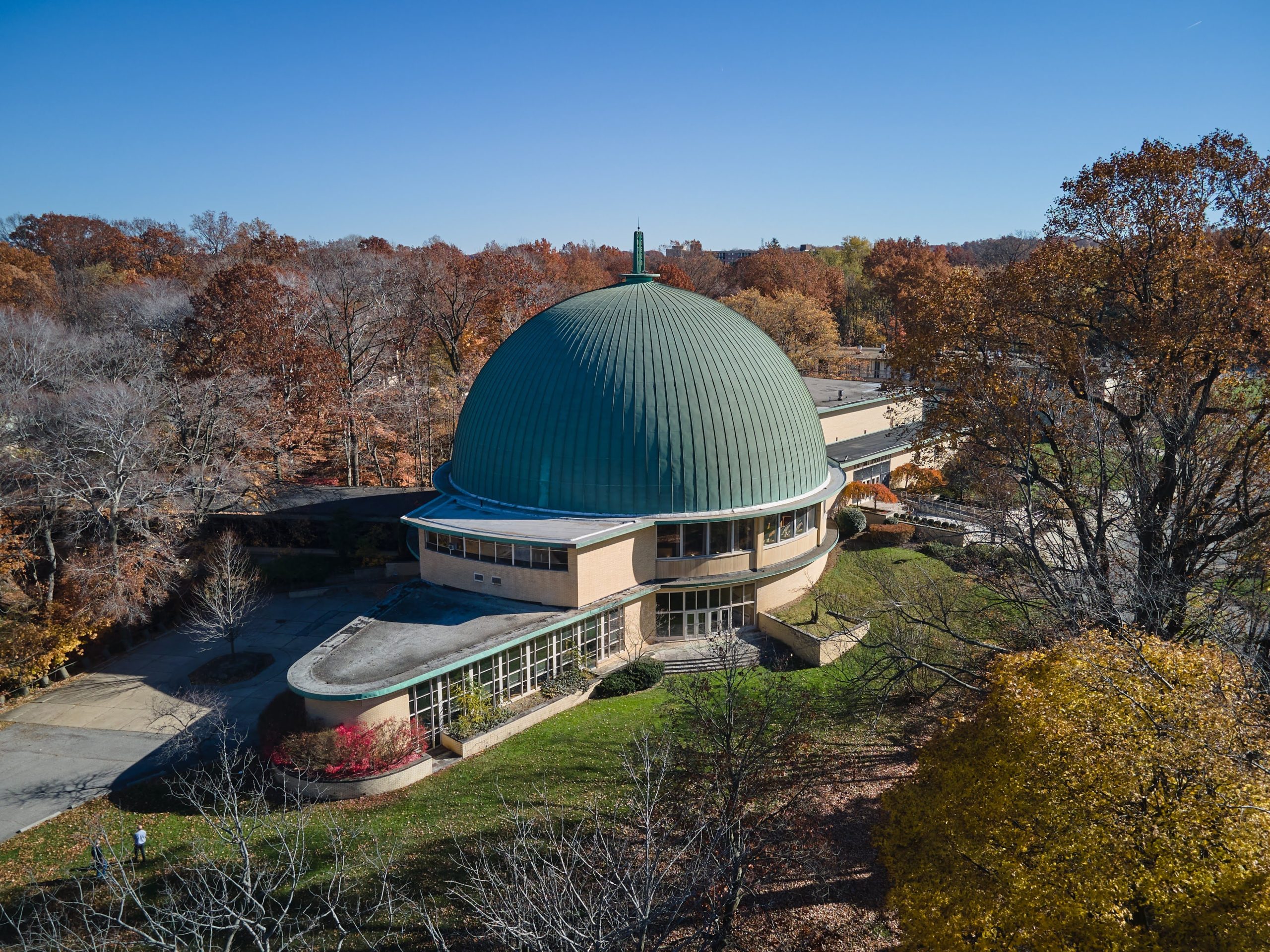The Plain Dealer: Park Synagogue, Mendelsohn Masterpiece, Awarded to SCA

Park Synagogue alarmed historic preservationists and fans of mid-century modern architecture earlier this year when it listed its main sanctuary and education building off Mayfield Road for sale.
But now it’s time to exhale. The 152-year-old Conservative Jewish congregation, which is centering its operations at a new worship and education campus in Pepper Pike, has come up with a new plan to preserve its historic building in Cleveland Heights, designed by the German-Jewish architect Eric Mendelsohn, a leading exponent of early 20th-century Expressionist architecture.
The congregation announced today that it has chosen to work with Sustainable Community Associates, a Northeast Ohio real estate partnership created in 2002 by three newly minted Oberlin College graduates who have spent two decades building or renovating more than $100 million worth of projects in Oberlin and Cleveland.
That represents good news for the synagogue building, a masterpiece by Mendelsohn, who fled the Nazis in 1933 eventually to establish himself in the U.S. as a designer of Jewish houses of worship.
Completed in 1950, Park Synagogue is widely considered a masterpiece by Mendelsohn, who fled the Nazis in 1933 eventually to establish himself in the U.S. as a designer of Jewish houses of worship.
Sustainable Community Associates has agreed to spend a year creating a master plan for the synagogue’s Cleveland Heights campus, and then carry out the resulting project as its master developer.
Park Synagogue’s goal is ultimately to transfer ownership of its Mendelsohn building and the surrounding 28-acre campus at 3300 Mayfield Road in Cleveland Heights while preserving and finding vibrant new uses for one of America’s most important examples of 20th -century religious architecture.
The central aim is to create an intergenerational community of new users on the campus, possibly including the arts, culture, education, housing, and human services in any number of combinations. In theory, the project would generate enough income or donations to preserve the historic Mendelsohn building.
The process will include market research and fundraising, plus discussions with foundations and potential users of the campus.
The synagogue and the development firm want to hear from interested organizations via the Sustainable Community Associates website.
The Mendelsohn building is known for its massive copper dome and sanctuary with a triangular chapel extending from its north side like the prow of a ship cutting through waves. A fan-shaped education wing and courtyard extend on the south side of the sanctuary.
Saving a masterpiece
The building is viewed widely as the most significant of the four synagogues Mendelsohn designed in America before his death in 1953 in San Francisco at age 66.
It is also arguably the most important building by a first-generation modernist architect in Northeast Ohio, a region long dominated by clients with unadventurous tastes in design. In that sense, the synagogue is especially significant locally as a rare progressive outlier in the region’s architectural history.
The building is showing signs of age. The congregation’s leaders estimate it could take at least $3 million to stabilize the structure, which needs masonry repairs and upgrades to its roof. They see the building overall as in fair condition.
When it listed the building for sale through Allegro Realty in May, the congregation raised the specter that it was eager to walk away from a costly burden, but that was never the intention.
“We all felt a real responsibility to making the best solution for Park Main because of its architectural importance, because of Park’s history and because of our commitment to Cleveland Heights and the good relationship we have with Cleveland Heights,” said Susan Ratner, president of the congregation since 2019. “We didn’t want to become part of the urban exodus.”
The Sustainable Community partners, Naomi Sabel, Josh Rosen, and Ben Ezinga initially learned that the Park Synagogue campus was on the market from friends in the congregation. After an initial visit, they initiated discussions with the congregation’s leaders, which led to a memorandum of understanding earlier this month.
The agreement coincides with a separate project by Park to expand its facility in Pepper Pike, where it built a new sanctuary, library, and education wing in 2005.
The congregation has raised $29 million in a $32 million capital campaign that includes money for the new building and an enhanced endowment. Construction is scheduled for completion in a year.
Ratner and Stuart Deicher, Park’s executive director, estimated that operating the Cleveland Heights campus, which includes a community mikvah, or ritual bath, and a daycare building, costs the congregation roughly $350,000 a year.
Precedent in St. Louis
During the upcoming year, Sustainable Community Associates will consult on the Park Main project with its longtime mentor, 1964 Oberlin College graduate Richard Baron, co-founder and chairman of the St. Louis-based real estate firm of McCormack Baron Salazar.
Baron established a powerful precedent for adaptive reuse of Park Synagogue when he led a successful effort in the mid-1980s to convert another important Mendelsohn synagogue, B’nai Amoona, into the home of the Center of Creative Arts, a leading regional arts center for children. Located in the St. Louis suburb of University City, the building now hosts programs for a racially diverse population of 50,000 children a year.
Speaking of the Cleveland Heights building, Baron said in an interview Wednesday that “it’s an exceptional piece of architecture, just extraordinary. My hope is that whatever emerges from the planning process will excite everyone in [Greater] Cleveland, and it becomes an important part of the fabric of the Cleveland cultural community.”
Baron is independently engaged in Cleveland as the developer of the first phase of Innovation Square, a project designed eventually to provide hundreds of new apartments south of the Cleveland Clinic in Cleveland’s Fairfax neighborhood along the new Opportunity Corridor boulevard.
Also consulting on the Park Synagogue project is Cleveland architect Jack Bialosky, leading principal of a firm established by his father, architect the late Jack Bialosky Sr., who knew Mendelsohn, and whose firm designed an expansion of the Park facility in the 1960s.
More than a building
The master plan could involve specifying the potential for new construction on undeveloped portions of the synagogue’s Cleveland Heights campus, including a large surface parking lot next to Mayfield Road currently used to park buses used by the Cleveland Heights-University Heights School District.
Forested areas on the campus would be preserved, but the developer and the congregation are also interested in exploring how the synagogue campus could become part of a system of trails and greenways that could connect to Cain Park in Cleveland Heights and to Forest Hill Park, part of which extends into East Cleveland.
Pursuing such goals would be one way to honor Mendelsohn’s original vision for the entire Park campus in Cleveland Heights.
“It’s the Mendelsohn campus that needs to be revitalized, not just the sanctuary,’’ Sabel said.
In a general sense, the congregation wants to emulate the example set by The Temple-Tifereth Israel in 2010 when it transferred ownership of its architecturally significant building in University Circle to Case Western Reserve University, which renovated it as the Maltz Performing Arts Center.
Under an agreement between the university and the Temple, the Reform congregation will have access to the facility for 99 years for eight days a year for use on major holidays and other events.
Ratner said Park Synagogue is looking for a similar arrangement at its facility in Cleveland Heights.
The issues faced by Park Synagogue are typical of those faced by numerous faith communities in urban areas across America, where congregations are migrating from older buildings in urban centers toward new facilities in ever-expanding suburbs.
Ratner said she was elated when Sustainable Community Associates expressed interest in Park Synagogue and offered to take on the project.
“This is the embodiment of everything you could hope for as you leave a place that holds your whole history,’’ she said. “I am really excited about this.”
Read Litt's full article in The Plain Dealer.
This article was originally published on September 17, 2021 in The Plain Dealer. Individuals or organizations interested in learning more should complete our inquiry form here.

